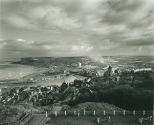"Disused railways? Forbidding factories? Decayed flats? All cities have them, and now photographer Gabriele Basilico has coaxed out their strange beauty," wrote The Independent (London) of the Milan-born photographer's book, "Cityscapes." The MIT Museum and the School of Architecture and Planning have teamed up to present the first major exhibition of Basilico's work in two different installations on campus through June 6.
Basilico, one of the leading photographers of the contemporary urban landscape, focuses on urban places in transformation: industrial borderlands, modern edge cites, and the boundary zones where old and new meet. His photographs of vacant factories, discarded commercial buildings and housing blocks, and the frayed edges of historic centers are works of, in architect Aldo Rossi's words, "morbid beauty."
Gary Van Zante, curator of architecture and design at the MIT Museum, will discuss Basilico's works in the museum's "Object Lesson" series today (March 17) at noon in the Compton Gallery.
"Basilico is fascinated by city building and how cities look," Van Zante said. "He creates meditative images of the most common places--discarded places that exemplify the precarious state of modern cities and the failures of planning. Through his participation in the public planning process, Basilico's photographs had a real impact on the lives of residents."
"Urban Renewal in Emilia-Romagna" at the Compton Gallery (Room 10-150) documents industrial archeology in 27 cities of northern Italy. Commissioned by the Emilia-Romagna region in 2001, Basilico's photographs served as instruments in a public planning process that sought to reintegrate these disused sites into the city.
"Basilico analyzes and describes the congestion of 20th-century cities, together with the refuse. He maintains that from the refuse can come the rebirth of cities. These are certainly not dead photos just because the show places devoid of life and people," said Emilia-Romagna city planner Piero Orlandi.
"Bord de mer: The DATAR Project" at the Wolk Gallery (Room 7-338) presents Basilico's portraits of the coastal towns and landscape of northern France in 1984-85, which he photographed for the Mission Photographique de la DATAR, the French regional planning authority's investigation into geographic identity and regional change.
In the introduction to the second printing, 18 years after the DATAR assignment, Basilico discussed his approach to the assignment. "The DATAR project led me to widen my horizons, introducing me to the natural landscape, leading me to include in my representation of places ever vaster, ever more distant spaces. This helped discover new vantage points and find a different and substantially slower visual rhythm," he said.
A version of this article appeared in MIT Tech Talk on March 17, 2004.






